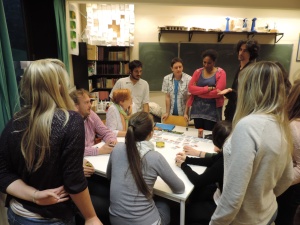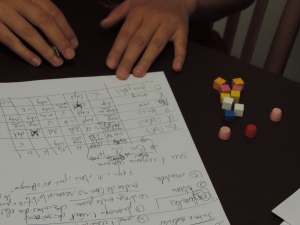My week in Brussels was insanely intense. I described the first workshop more than a week ago, so it’s time to tell you more about the remaining workshops.
Wednesday 24th – HEB Defré “Game science and technics”
Like most of the workshops given this week, this one was given during the evening. It took place in the Games library of a school in Uccel, in the suburbean-like area of Brussels. Every wednesday, the Game library is open to public, so some people coming every week or so have heard of the workshop and came to create a game.
But most of the attendees were students in a 1 year game technics cursus. They want to be able to use games in their job, create games, open public game librairies or board game cafes, but whatever their final goal might be, they were really looking forward to create a prototype.
Of course, this very particular context pressurized me a bit. Those people are going to be professionals in the field of game (when they are not already), they have a large game culture and game design exigence. This workshop was actually a course !
But fortunately, everything went smoothly. I brought 2 sets of Mechanicards, as well as 2 Dobble and 2 Zombie dice games, so the workshop could take place with 2 groups. Each group played Dobble, then analyzed it, then added some Bluff, then the same operation was repeated with Zombie dice (and Cubes instead of Bluff). Once everybody finished an analysis or a card inclusion, one group presented his work to the other to confront it.
Mostly due to a large break time, I didn’t manage my timing proprely, so everybody had a minimum amount of time to create the actual prototypes – about 45mn after I gave cards and tips. So I had to make it up by defining the remaining time precisely : each group had 20mn to brainstorm, 20mn to create a prototype and then 5mn to switch tables so other people could test their game. The theme was “Harpist”.
This was quite an interesting exercise tho. Instead of creating a whole game, the workshop attendees had to create a small gameplay element.
The games may be reworked afterwards during the formation, which makes the workshop more useful !
Thursday 25th – La Table – Food & Games
For starters, La Table is an amazing place. The title says it all : La Table Food & Games is a restaurant fully packed with very diverse board gams, so you can come, have a drink, eat something, play, meet new players, mix everything and have fun. Sounds great ? It is.
The workshop started with 5 people and ended up with 2 people once the actual game creation part started. However, this wasn’t a problem at all. The 5 attendees were regular players, so the analysis & rules addition part was done in a breeze.
As for the game creation itself, I gave the theme “Shadow play”. The cards were “Board”, “Material placement” and the dreadful “General knowledge”, which was quickly cast away by the attendees !
We had enough time to test the prototype 2 times. The second time, I played myself with another player not involved in the prototyping session. Our game lasted 30mn and was quite exciting. I really think this game can lead to something interesting.
It consists of a symetrical squared board with larger squares inside. Each player starts with 3 pawns on one side of the board. There is also a “Sun” on the middle of the board. Each player plays turn by turn. A turn consists of 2 actions :
– Moving a pawn (if it’s possible);
– Moving the Sun (not mandatory).
You can move the sun on any side or corner of the board. Sun cast shades : when comes the time to move a pawn, you can’t do it if the pawn is in the “shade” of another pawn. So if the sun is on the right side of the board, and my pawn is on the left of another pawn, I can’t move it.
This simple yet tricky concept is very satisfying to play and I’m very thrilled to see what emerged from this workshop.
Friday 26th (day) – Helmet institute – Schaerbeek
This workshop started at 8:30 am and finished at 3:20pm with several breaks in between. The breaks were mandatory because the workshop took place in a school with 23 children from 8 to 9 years old.
Yep.
I couldn’t take much pictures of the workshop for right issues (you know… children). I was invited by the teacher, Bénédicte, and the children already played some games the weeks (and years) before, so felt somehow easy with games. Still, they were 8-9 years old, so I obviously had to set up a very special workshop, which was at the same time very exciting and very challenging.
We spent more time playing games, this time 3 of them : Dobble, Zombie Dice and Wink. We divided the room in 3 sets of tables so the children could play one game and then change table. Once they played every game, a guided session of game analysis took place with 3 sets of Mechanicards (I removed some hard cards before, such as “Narration”, “Draft”…). We helped them of course, but the results were quite interesting and accurate.
Of course, explaining why Zombie dice was a game using Calculations (“So, you have dices, and you can calculate the probabilit–wait…”) or what the hell is “Logic” was rather challenging, but at the same time interesting I guess.
Afterwards, I gave each child a secret card, and their challenge was to trade it with another child if he didn’t like it. So basically, 23 children were running in a classroom with Mechanicards, saying “I want your Dice card, do you want my Cooperation card ?”. Fun.
We then noted whom child had which card, went to lunch break and created not-so-random groups of 3 children. Then the creation started.
I didn’t even try to tell them not to take too much care of the visual of their game as it’s so very, very satisfying to create something fancy when you are 8 years old. For the first part of the prototyping session, we asked the children not to take any game material (except paper and pens) so they could focus on brainstorming (!). They struggled a bit in the beginning, but after we guided them a bit, they were ready to go.
I couldn’t focus enough to remember precisely all the games they created. So, yeah, most of them created Snake and ladders games or variations of Memory games for what it matters. However, some very interesting ideas came out when we tried to ask them questions such as “so, how do you play your game ?”. We had some time to have them test games created by other children, so they had to explain games to other children, which was quite difficult… and instructive.
This workshop changed the way I’m seeing the Mechanicards method. I think the approch has a lot of hidden potential I absolutely didn’t have in mind when I created them, and I’m very happy to see that they can be used in such an educative way. I’m looking forward to see how they are going to be used by the structures to which I leave a set of cards.
Friday 26th (evening) – Let’s play together
Remember Let’s play together ? This awesome association, organizing various events around Brusseld based on board games, asked me to do a “VIP workshop” during the evening. As I’m leaving a set of cards to them, we took some time to analyze the tool and see what could be improved.
The workshop itself was quite shorter, but as most people here were already familiar with Game design, the concepts created were quite interesting. The theme, given by somebody on Facebook (follow the page if you want to propose another theme later on !), was “Atoms”.
The first game created was based on atoms crafting. Each player starts with several random atoms, and the goal of the game is to create a precise chemical formula (HBrCl). Each turn, a player can activate his first or last atom to make it interact with another atom in the middle or possessed by another player.
The interactions between atoms is defined by an interaction grid. Due to the lack of time, we couldn’t test it enough times to simplify it a bit, so it was quite experimental.
The second game was based on memorization. You have to create an atom balanced between positive charges, negative charges and neutrinos. There’s a 3 pile of cards (protons, electrons, neutrinos), you can see each pile one time at the beginning of the game, then you have to memorize them. One pile is set on the middle and people have to bet points to define the card picking order.
















